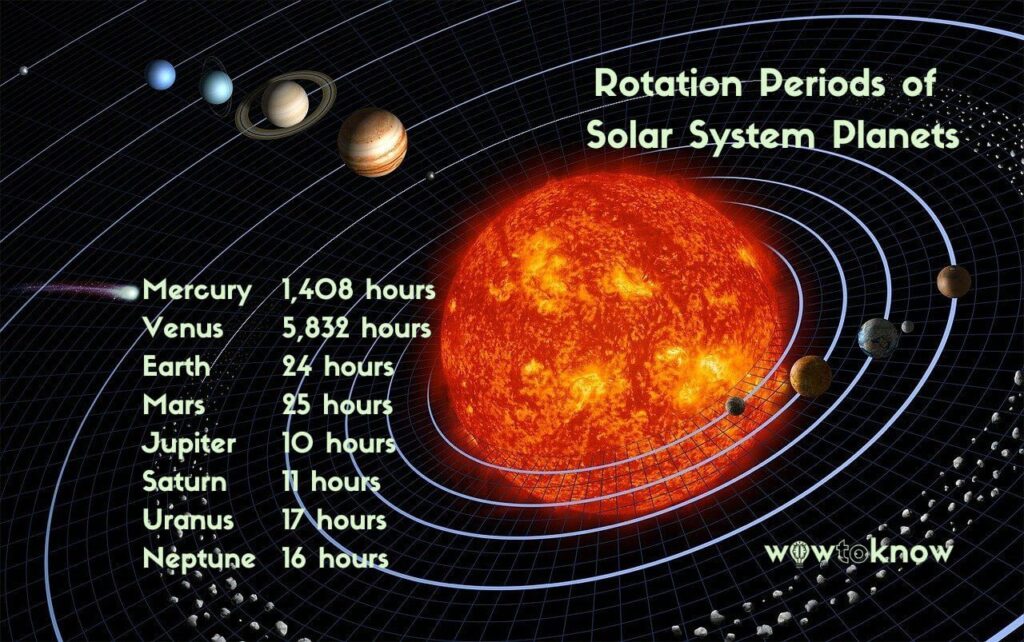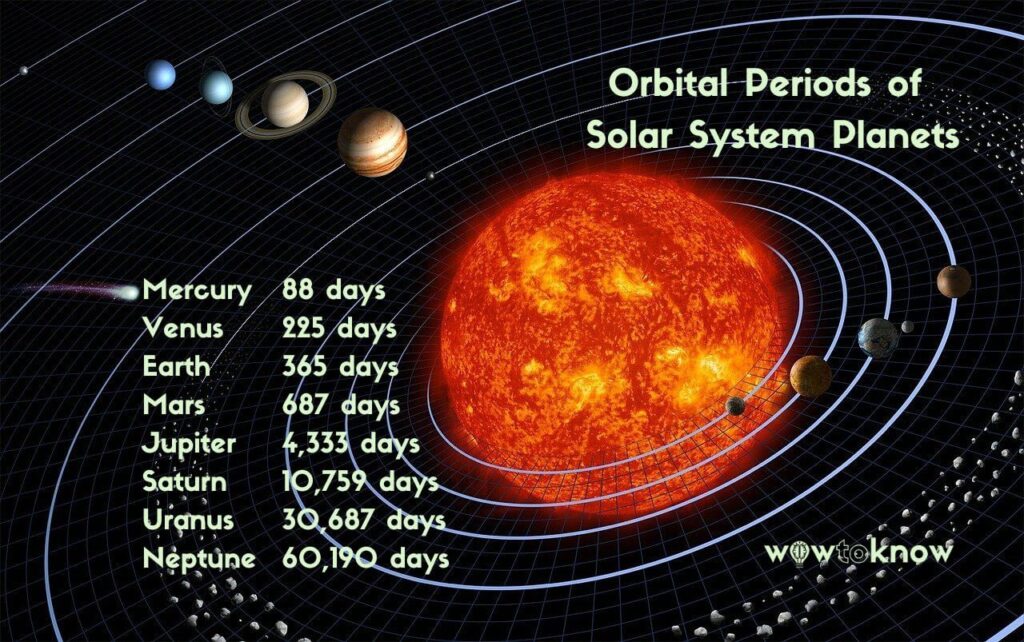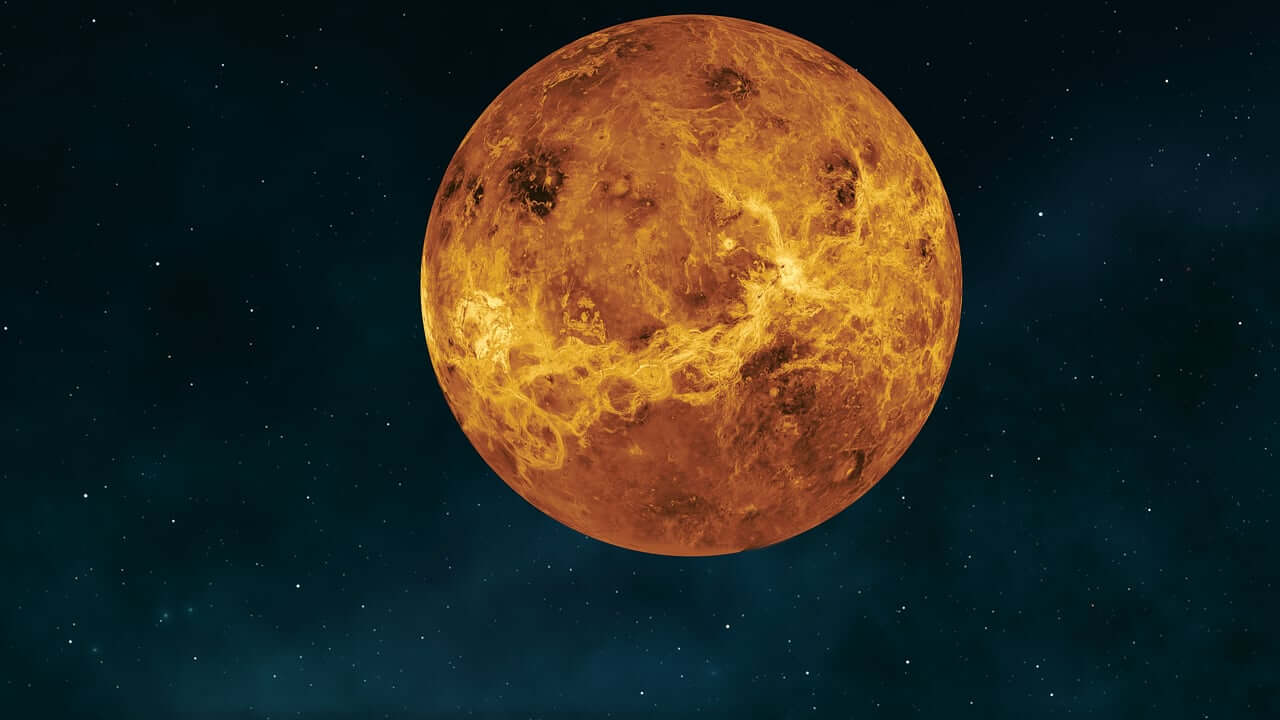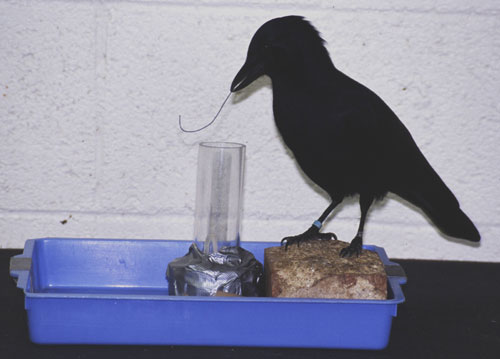Venus, our neighbor in the solar system, orbits around the Sun faster than rotates on its axis. This is just one of many fun facts about Venus, the planet that really makes you go wow.
Venus’ Rotation Period
The time it takes for a planet to complete one full rotation on its axis is called its “rotation period” or “day.”
On Venus, it takes approximately 243 Earth days or 5,832 hours for the planet to complete one full rotation.
This is by far the slowest rotation period among the planets in our solar system. It’s four times slower than the next contender, Mercury, the first planet from the Sun. A day on Mercury is equivalent to 1,408 hours, or around 59 Earth days.
Aside from Venus and Mercury, only Mars has longer days than Earth – 25 hours. The rest of the planets only take 10 to 17 hours to complete a single rotation.

Venus’ Orbital Period
The time it takes for a planet to complete one orbit around the Sun is called its “orbital period” or “year.”
For Venus, this period is about 225 Earth days.
This means that Venus orbits the Sun faster than it rotates on its axis.
Orbital periods (or years) depend on the planets’ positions from the Sun. Years are shorter on planets that are closer to the Sun.
There are two main reasons for this:
1. The closer a planet is to the Sun, the shorter its orbital path, i.e. the distance it orbits.
2. The closer to the Sun, the stronger its gravity. Stronger gravity makes planets orbit faster.
This is why Mercury only takes 88 Earth days to orbit the Sun while Neptun takes 60,190 days for the same operation. That’s a whopping 684x difference.

Days vs Years on Venus
Because Venus rotates so slowly compared to its orbital motion, its day (rotation period) is longer than its year (orbital period).
In other words, a day on Venus (one full rotation) takes longer than a year on Venus (one orbit around the Sun).
The reason for this odd rotation and orbital relationship is due to a combination of factors, including gravitational interactions with the Sun and other planets over the course of Venus’s formation and evolution.
These interactions can lead to complex orbital dynamics and tidal forces that influence a planet’s rotation and orbital characteristics.
Venus’ Weird Rotation
Venus’ rotation is also peculiar in that it rotates on its axis from east to west. If you had an opportunity to stand on the surface of Venus, you would see the Sun rising in the west and setting in the east.
This is unusual because most planets rotate in the direction of their orbit. Aside from Venus, only Uranus rotates in the opposite direction compared to its orbit in the solar system.
Such rotation is called retrograde rotation, contrary to the prograde rotation of the Earth and most other solar system planets.
10 Facts About Venus
Check out more interesting facts about Venus for kids and all curious minds.
Hottest Planet: Despite not being the closest planet to the Sun, Venus is the hottest planet in our solar system. The surface of Venus can heat up to 900 degrees Fahrenheit (475 degrees Celsius). This is hotter than the surface of Mercury, the closest planet to the Sun (up to 800 degrees Fahrenheit or 430 degrees Celsius).
Runaway Greenhouse Effect: Venus’s extreme surface temperatures are a result of a runaway greenhouse effect. The thick carbon dioxide atmosphere traps heat and prevents it from escaping, creating a scorching-hot surface.
Atmospheric Pressure: Venus’ atmosphere is extremely dense and composed mainly of carbon dioxide. The atmospheric pressure at its surface is about 92 times that of Earth’s, equivalent to the pressure experienced 900 meters (3,000 feet) underwater on Earth.
Volcanic Features: Venus has a large number of volcanoes on its surface, with some of them being among the largest in the solar system. One of the most famous is Maat Mons, which is taller than Mount Everest and is believed to be geologically active.
Surface Geology: Venus’ surface is covered in vast plains, highland regions, and large impact craters. Due to the extreme temperatures and pressure, any liquid water on the surface would boil away quickly, making the planet’s surface very different from Earth’s.
Retrograde Rotation: As previously mentioned, Venus rotates on its axis in the opposite direction (retrograde) compared to most other planets. As a result, the Sun on Venus rises in the west and sets in the east.
Lengthy Sunrises and Sunsets: Because of its slow rotation and thick atmosphere, Venus experiences long sunrises and sunsets that can last for several hours.
Lack of Moons: Venus doesn’t have any natural moons, which is somewhat unusual for a planet of its size. The reason for this absence is still a topic of scientific investigation.
Similar Size to Earth: Venus and Earth are often called “sister planets” due to their similar size and composition. However, Venus’ extreme conditions make it a challenging place for life as we know it to exist.
Spacecraft Exploration: Several spacecraft, including the Soviet Union’s Venera missions and NASA’s Magellan spacecraft, have studied Venus up close. These missions have provided valuable insights into the planet’s geology, atmosphere, and surface conditions.
FAQ
Why days are longer than years on Venus?
A day on Venus is longer than its year because Venus has a very slow rotation on its axis, taking about 243 Earth days to complete one rotation. In contrast, its orbit around the Sun only takes about 225 Earth days, resulting in a day on Venus being longer than its year.
What makes Venus’ rotation special?
Venus rotates in the opposite direction to its orbital motion. This rotation pattern is called retrograde rotation. Aside from Venus, only Uranus has retrograde rotation in the solar system. Other planets including Earth have prograde rotation, which means they rotate in the same direction as they orbit the Sun.
How hot is Venus?
Venus is the hottest planet in our solar system, despite being farther than Mercury from the Sun. Venus’ ground temperatures can reach up to 900 degrees Fahrenheit (475 degrees Celsius).
Such high surface temperatures are primarily due to the thick atmosphere composed mainly of carbon dioxide, which creates a strong greenhouse effect. The atmosphere traps heat from the Sun and prevents it from escaping into space, which makes Venus’ temperature extremely hot.
What color is Venus?
Venus appears to be a bright, white-yellowish color when observed from Earth. This color is mainly due to the reflection of sunlight off its thick cloud cover. The clouds in Venus’ atmosphere consist of sulfuric acid and other particles which scatter sunlight and create the planet’s distinctive coloration.
What does Venus’ sky look like?
Venus has a unique and striking appearance in its sky due to its thick atmosphere and various atmospheric phenomena. The sky on Venus is generally overcast, covered by thick clouds composed mostly of sulfuric acid. These clouds create a diffuse and uniform illumination.
How many moons does Venus have?
Like Mercury and unlike the other planets in our solar system, Venus does not have any natural satellites (moons) that orbit around it.
What are some interesting facts about Venus?
Venus’ day (rotation period) is longer than its year (orbital period) due to its slow rotation.
Venus’ surface temperatures are hot enough to melt lead due to a runaway greenhouse effect.
Venus rotates on its axis in the opposite direction to most planets, causing the Sun to rise in the west and set in the east.
Venus has immense pressure and acidic clouds, making it one of the most inhospitable places in the solar system.
Venus exhibits phases like the Moon when seen from Earth, ranging from crescent to nearly full.
Venus has super-fast winds in its upper atmosphere that circle the planet faster than its slow rotation.




